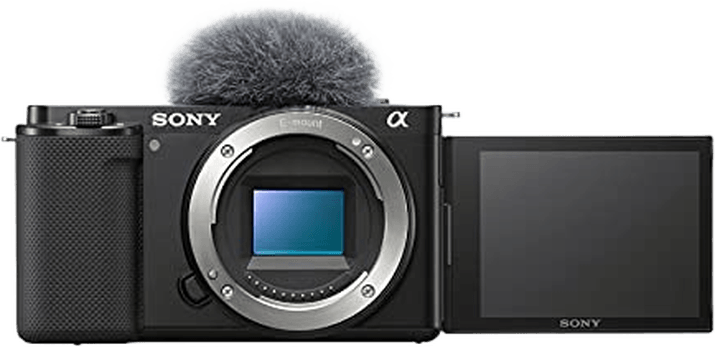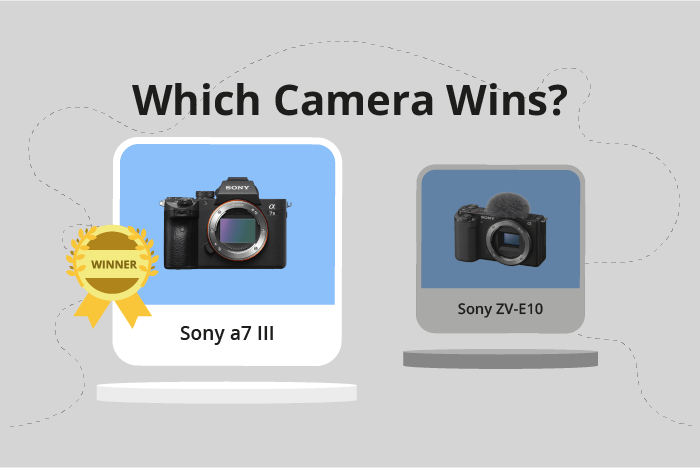Sony a7 III vs ZV-E10 Comparison
Sony a7 III

Sony ZV-E10

The Sony a7 III emerges as the winner with a score of 80/100, while the Sony ZV-E10 trails behind at 65/100. Both cameras share the common feature of being mirrorless. However, the a7 III, released in 2018, boasts a higher launch price of $2000 compared to the ZV-E10’s $700, reflecting its superior quality.
The a7 III’s edge comes from its larger size (127 x 96 x 74mm) and heavier weight (650g), which may offer better stability and durability. On the other hand, the ZV-E10, released in 2021, has a smaller size (115 x 64 x 45mm) and lighter weight (343g), making it a more portable option for those prioritizing convenience.
Taking these factors into account, the Sony a7 III provides a more robust and high-quality experience, while the Sony ZV-E10 offers a more budget-friendly and portable alternative.
Sony a7 III vs ZV-E10 Overview and Optics
The Sony a7 III takes the lead in our optics comparison with a score of 81/100, while the Sony ZV-E10 trails behind at 69/100. Both cameras share some common specifications, such as a 24-megapixel CMOS sensor, Bionz X processor, and the ability to shoot at fast speeds (10 fps for the a7 III and 11 fps for the ZV-E10). However, the similarities end here, and the differences in their optics become more apparent.
The a7 III outperforms the ZV-E10 in several aspects. It has a full-frame sensor, which provides better image quality and low-light performance compared to the ZV-E10’s APS-C sensor. The a7 III also boasts a higher DXOMARK score for its sensor at 96, compared to the ZV-E10’s 86. Additionally, the a7 III features built-in image stabilization, which is absent in the ZV-E10, making it a better choice for photographers who need steady shots. The Sony FE lens mount on the a7 III offers a wider selection of lenses for various shooting situations, compared to the Sony E mount on the ZV-E10.
On the other hand, the ZV-E10 has a slight edge in shooting speed at 11 fps, compared to the a7 III’s 10 fps. It also has a 4:3 aspect ratio, which may be preferred by some photographers for specific compositions. However, these advantages do not outweigh the overall superiority of the a7 III’s optics.
The Sony a7 III clearly outshines the ZV-E10 in terms of optics, offering better image quality, low-light performance, and image stabilization. While the ZV-E10 has a few advantages, such as a faster shooting speed and a different aspect ratio, these do not make up for the substantial gap in optical performance. Therefore, the a7 III is the superior choice for those seeking top-notch optics in their camera.
Sony a7 III vs ZV-E10 Video Performance
The Sony ZV-E10 outperforms the Sony a7 III in video capabilities with a 91/100 score compared to the a7 III’s 56/100. Both cameras share some common specifications, such as 4K maximum video resolution and max video dimensions of 3840 pixels. However, the ZV-E10 surpasses the a7 III in several aspects, making it the superior choice for video recording.
The ZV-E10’s higher score is due to its impressive maximum video frame rate of 120fps, allowing for smoother slow-motion footage. This is a significant advantage over the a7 III, which has a max frame rate of only 30fps. Additionally, the ZV-E10 comes with time-lapse functionality built in, a feature absent in the a7 III. This offers users more creative options when capturing video.
While the a7 III lags behind the ZV-E10 in video capabilities, it still provides decent performance with its 4K resolution and 3840 x 2160 video dimensions. For those who do not require high frame rates or time-lapse features, the a7 III may suffice.
When comparing the two cameras for video capabilities, the Sony ZV-E10 is the clear winner due to its higher frame rate and time-lapse functionality. The Sony a7 III, while adequate for some users, falls short in these areas. Those seeking superior video performance should opt for the Sony ZV-E10, while the a7 III may be suitable for those with more basic video needs.
Sony a7 III vs ZV-E10 Features and Benefits
The Sony a7 III wins the features comparison with a score of 81/100, while the Sony ZV-E10 scores 68/100. Both cameras share common specs, including a 3-inch screen, touchscreen capabilities, flip screen, GPS, WiFi, and Bluetooth connectivity.
The Sony a7 III outperforms the ZV-E10 in screen resolution, boasting 921,600 dots compared to the ZV-E10’s 920,000 dots. This difference provides a slightly clearer and sharper image on the a7 III’s screen, enhancing the user experience when composing shots and reviewing images.
Despite the lower feature score, the Sony ZV-E10 has its advantages. The camera is specifically designed for content creators and vloggers, offering user-friendly features and a more compact design. This makes it a more suitable choice for those who prioritize portability and ease of use over the a7 III’s advanced features.
To conclude, the Sony a7 III is the superior camera in terms of features, with a higher score and better screen resolution. However, the Sony ZV-E10 caters more to content creators and vloggers who value portability and user-friendly features. Ultimately, the choice between these two cameras depends on the user’s priorities and intended use.
Sony a7 III vs ZV-E10 Storage and Battery
The Sony a7 III outperforms the Sony ZV-E10 in storage and battery with a score of 68/100, compared to the ZV-E10’s 24/100. Both cameras accept SD/SDHC/SDXC and Memory Stick Pro Duo memory cards, but the a7 III has two memory card slots while the ZV-E10 has only one.
The a7 III’s battery life is superior with 750 shots per charge, using the NP-FZ100 battery type. In contrast, the ZV-E10 offers 440 shots per charge and uses the NP-FW50 battery type. Neither camera supports USB charging.
The a7 III’s advantages include longer battery life and an additional memory card slot, providing more storage and flexibility. The ZV-E10 does not have advantages in storage and battery compared to the a7 III.
Considering the significant differences in storage and battery capabilities, the Sony a7 III is the clear winner in this comparison. The added memory card slot and extended battery life make it a more suitable choice for extended shooting sessions and demanding applications.
Sony a7 III vs ZV-E10 – Our Verdict
Are you still undecided about which camera is right for you? Have a look at these popular comparisons that feature the Sony a7 III or the Sony ZV-E10:

